Portions of this site and the works within it are being produced with the intention of critique and/or educational use under Australia's 'fair dealing' exceptions to copyright (Sections 40 & 41). However, if you feel your IP is being infringed, please contact my service provider (Tumblr) with the appropriate DMCA requests, as I, the single author take full responsibility for the content of this site.
Don't wanna be here? Send us removal request.
Text
WEEK 10: Online harassment, uncontrolled language, and death threats. One-click from an anonymous through the screen
From bullying to slander and insults in cyberspace, 'online toxicity' is a fact of life for everyone, in which women, and teenagers... are the most victims easily targeted.
According to a nationally representative Pew Research Center online survey of over 10,000 American adults conducted in September 2020, 41% of Americans have at least once been the victim of online harassment in one of six categories: being called derogatory names, being deliberately embarrassed, being stalked, being physically threatened, being harassed for an extended period, or being sexually harassed (Bertazzo, S 2021). The Center's 2017 poll on the subject yielded a comparable proportion, but more recent data indicates a rise in claims of more serious offenses including sexual harassment and stalking. Even if there may not be a general increase in online harassment, the problem is becoming worse. It is evident that an increasing number of individuals have either encountered or are now enduring violent threats, stalking, persistent harassment, and sexual harassment, among other more severe forms of conduct.
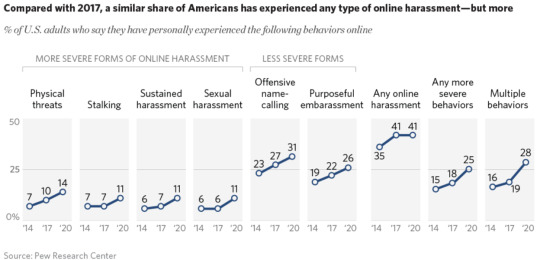
According to recent research, over half of the questioned teens reported experiencing significant harassment online, and around two-thirds of individuals under 30 reported having encountered online abuse. Out of ten adult LGBTQ people, seven have been the victim of abuse online, with 51% being the subject of more serious kinds of harassment. In general, males report experiencing online harassment at a higher rate than women (43% versus 38%), while the rates of more severe kinds of online abuse are comparable for men and women. Additionally, studies show that women are twice as likely as males to report that they were very or severely disturbed by online abuse.
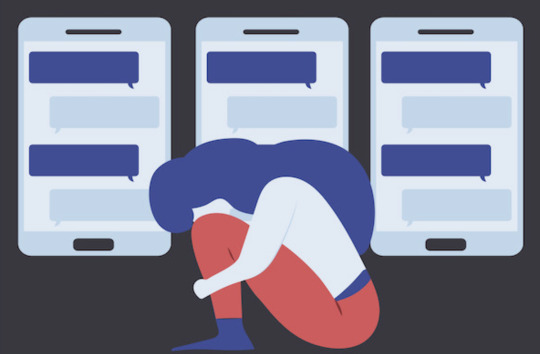
People's ability to engage with their communities through the internet and digital tools is becoming more and more dependent on them. These tools are used for everything from information sharing and searching to entertainment and sensitive question solving, education, and access to the outside world. The internet is predicated on the notion of free speech as well as the unrestricted exchange of information. Aside from emails, posts, chats, and livestreams on social media, the proliferation of the internet has also led to a diversification of targeting methods. Online harassment has become a common problem due to several factors, including the rising use of cell phones, extensive internet coverage, and more affordable costs. The majority of harassers, it is noteworthy, either deliberately ignore or are oblivious to the significant "real" implications of their actions. People can express themselves and seek information about their sexual orientation and identity on the internet, but many are attacked for doing so. These attacks can take many different forms, such as sexual assault, the disclosure of personal information, and image manipulation that is then used for extortion and reputational harm. Research indicates that political opinions, gender, attractiveness, and ethnicity are the most often targeted human or physical attributes in online abuse (Maeve Duggan 2017). Online harassment may take many different forms, such as doxing, online sexual harassment, distributed denial-of-service (DDoS) attacks, and stalking.

Effective social media management strategies necessitate a thorough comprehension of the numerous harms connected to distinct types of online harassment. Cyberbullying may have serious, perhaps irreversible effects on a victim's physical and emotional health. The nature of the action itself might have repercussions, even if the impact of harassment can differ based on its particular form. Devastating results can result from persistent harassment; many victims, particularly women, have spoken out about being the target of unwanted attention regularly when using the internet (Massanari, A 2016).
With a single click, online bullies, who are frequently geographically scattered and challenging to locate, may harass and abuse their victims in front of an infinite number of people. This typically presents serious obstacles for victims who want to take legal action. Additionally, a lot of young people make the mistake of thinking that since the internet gives them total anonymity, there won't be any repercussions for their horrible actions. The growing number of incidents of online harassment indicates that insufficiently strong safeguards are in place to stop online abuse. The term “anonymity” describes the practice of posting anonymous comments on chat rooms and social media sites that cannot be linked to a particular person. A person may choose a pseudonym rather than their own name if they wish to be incognito. Bullies may decide to use a pseudonym as a means of hiding their true identity when harassing others online. In fact, the victim might never find out who the bully is. The bully may hide in quiet places, even their own house, and act in ways they wouldn't otherwise be able to since they can stay unknown. Because they are anonymous, invaders can intimidate, threaten, or degrade others without worrying about repercussions or being recognized.
Therefore, we need to equip ourselves with the necessary skills to deal with these issues:
Block social media accounts with malicious intent: One of the common but insidious forms of online bullying is sending threatening messages. Bullying messages are not always explicit. Indeed, with such a message, you may never truly understand the sender's intentions. If this information frightens you, perhaps you should consider whether it could escalate into action. The best way to prevent online bullying is to block social media accounts deliberately sending threatening emails and messages. This prevents malicious individuals from accessing you further.
Preserve evidence: Evidence of threats, harassment, provocative messages, and harmful comments should be documented in real-time. In addition to keeping digital records, print them out when necessary.
Talk to a trusted person: Speaking to parents is not easy for everyone. But when faced with unresolved issues, you should talk and seek advice from your parents.
Limit the disclosure of personal information on social media: New users of social media often do not realize the risks when personal information is made public on online platforms. When something bad happens, users can become excessively stressed. That's why it's important to learn how to use social media correctly and know what information should be shared. Sometimes, you may not realize that you are sharing unwanted personal information online.
Report to authorities: In severe cases, report to the nearest law enforcement agency for legal processing. Strict compliance with the provisions of the Cybersecurity Law is also a way to protect yourself from cyberbullying. The difference between freedom of speech and personal insult is clear. Taking decisive action to end online bullying.
Avoid provoking the perpetrator: A strong reaction can exacerbate the situation and anger the bully. Depending on the situation, you may consider ignoring online provocative behavior and blocking or reporting such behavior to the website or social media platform. Usually, bullies are more interested when victims respond. If you receive emails or text messages from strangers, consider switching to a different email address, phone number, or social media account.
Conclusion
Digital technologies and the internet are playing a bigger role in communication and social interaction, but they also create more avenues for abuse and harassment online. Many victims of online harassment suffer severe psychological and bodily suffering in addition to being inconvenienced, with long-lasting effects. Even if there are several ways to deal with online harassment, to properly handle this issue, the community and authorities must agree and show support.
In this situation, it is crucial to have a thorough awareness of the different types of online harassment and to implement the necessary safety precautions. The most crucial thing, though, is to provide a kind and safe online space where individuals may communicate constructively without worrying about danger or injury. Technology leaders and the online community face a big problem here, but there's also a chance to create a safer and more pleasant social media environment for everybody.
Reference list
Bertazzo, S 2021, ‘Online Harassment Isn’t Growing—But It’s Getting More Severe’, pew.org, viewed <https://www.pewtrusts.org/en/trust/archive/spring-2021/online-harassment-isnt-growing-but-its-getting-more-severe>.
Maeve Duggan 2017, ‘Online Harassment 2017’, Pew Research Center: Internet, Science & Tech, viewed <https://www.pewresearch.org/internet/2017/07/11/online-harassment-2017/>.
Massanari, A 2016, ‘#Gamergate and the Fappening: How Reddit’s algorithm, governance, and Culture Support Toxic Technocultures’, New Media & Society, vol. 19, no. 3, pp. 329–346, viewed <https://journals.sagepub.com/doi/10.1177/1461444815608807>.
Mishna, F, Saini, M & Solomon, S 2009, ‘Ongoing and online: Children and youth’s Perceptions of Cyber Bullying’, Children and Youth Services Review, vol. 31, no. 12, pp. 1222–1228, viewed <https://www.sciencedirect.com/science/article/pii/S0190740909001200>.
0 notes
Text
WEEK 9: Gaming Communities, Social Gaming, and Live Streaming
The heat of the Game Community and Live Streaming platforms
Thanks to advancements in contemporary technology, live streaming on social media has emerged as one of the most engaging communities in recent years, facilitating instantaneous connection and real-time content creation. The ability to live-stream video games is predicted to spark a new and remarkable technological wave due to the growing popularity of the gaming industry. This is especially true with the emergence of online platforms like Facebook Gaming, Twitch TV, and Nimo TV (which is popular in Vietnam), which facilitate the sharing and consumption of real-time content. Because of this, more and more individuals are becoming interested in playing online games, and the online gaming market is booming in the modern digital age. Gamers have come together to create new communities in which they discuss and exchange crucial information about the growth and success of video games, including strategy building, match analysis, the attraction of various game genres, and even commentary on characters, abilities, and outfits at every stage of the game. However, joining or starting a gaming community is difficult, and certain ideas might be confusing.
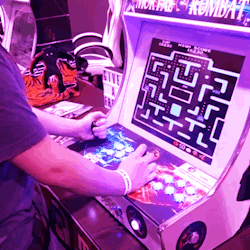
First, let's examine the distinctions between virtual gaming communities and authentic communities. A traditional community is made up of individuals who have a common meaningful tale that characterizes a facet of their humanity. In traditional communities, they look for others who share their beliefs and interests among their neighbors, coworkers, acquaintances, and friends of friends. We can easily access venues to discuss our favorite subjects in gaming communities and virtual platforms. From there, we may meet others who share our interests or who use language in a way that appeals to us. From there, it's evident that, in comparison to more conventional approaches to locating peer groups, the likelihood of making friends in this community will improve several times over. Consequently, if we look at the definition of gaming communities, we can say that they are essentially made up of people who come together to connect both online and offline while sharing a passion for playing video games. It might include players from all across the world or just those in the neighborhood. The goal of gaming communities is to help players become friends and encourage one another while also offering tips on how to get better at various games.
The success of the gaming business today greatly depends on the creation and growth of gaming communities. Why am I saying this? Games may be viewed as a kind of entertainment since people who share similar interests and objectives have formed the perfect gaming community. This has led to a boom in the business, and it will likely continue to grow in the near future. As per PwC's research, Global Entertainment and Media Outlook 2022-26, the gaming industry is estimated to reach a valuation of $321 billion by 2026 due to its anticipated growth.
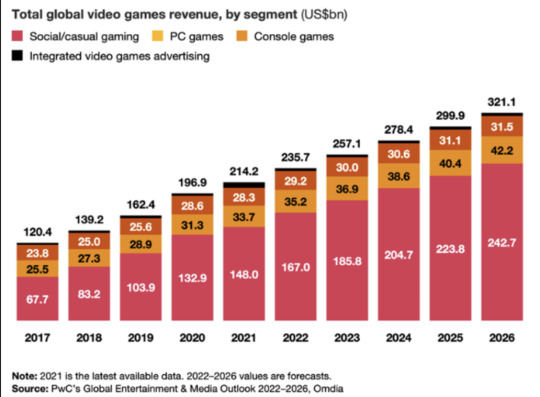
Starting from 2017, the profit generated and earned from users participating in online social games has increased significantly. This includes not only various gaming fields or games played on different gaming devices such as PC games and console games but also integrated electronic game advertising, all of which have been increasing annually with no signs of decline until 2026. Therefore, we can clearly see that gaming cannot be denied as one of the key industries in a continuously developing society, whether in a developing or developed country. This has demonstrated one thing: electronic gaming has evolved into a billion-dollar business industry, with millions of consumers. Gaming platforms combined with live streaming platforms have continued to significantly impact the culture and gaming experience over the years. The gaming community is almost a crucial link in this industry. Why do I say that? It is because each person in the community is connected through gaming strategies and their communication differs from traditional communication.
So the question here is, with the continuous development of this industry and the explosive growth of the gaming community, does it change the perspective, behavior, and attitude of society?
Obviously, everything will have its two sides, however, what the gaming community has brought to society is something that needs to be mentioned. Playing a vital role in determining players' motivations, social effects, and emotional states, games often have high adaptability, and both individual players and the community as a whole need to supplement this adaptability. This can create new opportunities to learn new behaviors and skills or develop existing ones. Changes in these behaviors can be observed in the personality of adolescents, as these changes must impact the development of the player's still-forming personality (Steinberg, L 2005). The table below, with various game genres, shows that players will accumulate certain skills (Quwaider, M, et al. 2019, p. 579):

The advantages listed in the data also demonstrate that, in addition to being a necessary component of game development, games genuinely provide us with pleasurable experiences that go beyond just amusement. Additionally, they acquire the requisite abilities that are relevant to a range of problems in modern society. The virtual gaming community (VG) has developed into a vibrant online community where individuals congregate for shared interests and create organizations on their own initiative, free from government oversight. These communities transcend the digital sphere, merging digital and real-world settings to create what academics refer to as the "third space" for social communication (Bourgonjon, J & Soetaert, R 2013). This dynamic is based on the concepts of interpersonal communication and information sharing, which also contribute to the description of the VG community as a space for social interaction and learning (Ritterfeld, U, et al. 2009). In addition to looking for areas of agreement, participants take part in instructional activities that are akin to those found in online learning communities.
The word "eSports", which stands for electronic sports, refers to the competitive practice of playing high-level video games and seeing others play them (Hamilton, W., et al. 2012). In the last fifteen years, the eSports scene has grown and changed. eSports fans now enjoy watching live streams of well-known players on the internet while they play their preferred video games. Electronic game viewing has evolved into a separate kind of entertainment as live streaming becomes more common (Kaytoue, M., et al. 2012). This trend has caught the attention of several media executives and game creators, who have changed the way they approach and present games to gamers. In addition to allowing for more feedback, interacting with a large audience via live streaming platforms and well-known individuals also helps electronic game developers gain more insightful information from fans and streamers, creating a relationship between the two parties and radically altering the way developers approach game design.
Case Study in Vietnam
The appeal and influence of the gaming community are significant factors contributing to the increasing popularity of gaming platforms. Individuals representing the community serve as a crucial link between the games and the community. They lead, experience new games, and provide objective critiques during live broadcasts. In Vietnam, Độ Mixi is a prominent example of these factors.
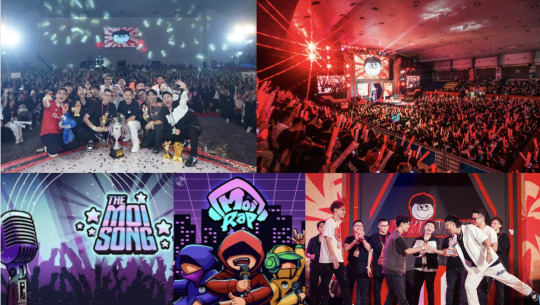
Độ Mixi gained widespread recognition as a popular streamer when he ranked in the top 4 strongest teams in PUBG Vietnam, securing a spot in the PUBG Southeast Asia Championship 2018. Later, he achieved the top 1 position (WWCD) in this tournament. These international competitions were notable milestones. At this time, the gaming industry in Vietnam was also experiencing significant growth, with a considerable increase in participants. The gaming community was gradually forming and growing strongly, marking a noteworthy development phase. For Độ Mixi, he has his own community, considered a gaming community. Besides connecting passionate individuals who share and discuss gaming interests, this community is where Độ Mixi shares activities he organizes for the community, such as creating tournaments for the younger generation and, importantly, reaching a broader audience.
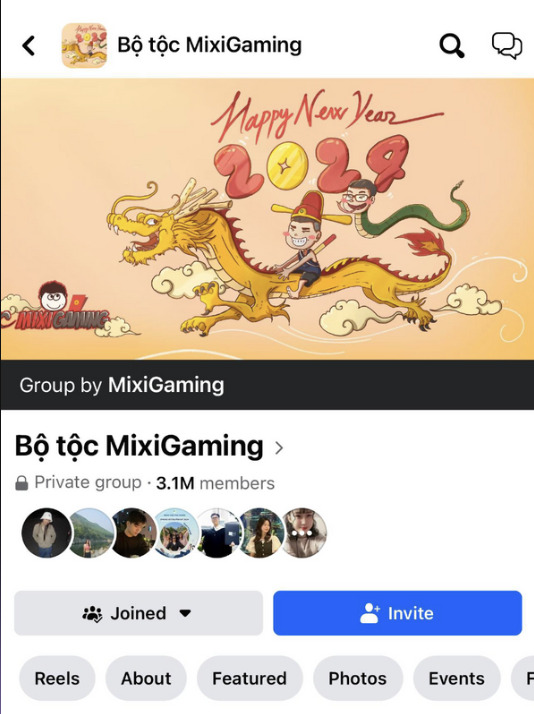
These are important factors contributing to the significant growth in community engagement, with the total number of members surpassing 3.1 million. Other notable figures include charitable donations, compiled from all viewer contributions throughout the year, considered contributions from the entire community, with charitable donations as follows:
Charitable contributions in 2022: 2 billion VND
For 2023: 2.5 billion VND
And, for 2024: 3.5 billion VND

Indeed, Độ Mixi's approach to community engagement is remarkable. His effective connection with everyone in the community reflects a successful community management model. This can be seen as an effective strategy for managing and supervising the gaming community, bringing positive values to society. It not only involves identifying attractive games and assessing them for the community but also significantly contributes to changing perceptions. This impact extends beyond the gaming community, prompting positive evaluations from individuals and groups outside the gaming community in society at large.
youtube
Moreover, he was the first person in Vietnam to assert sovereignty over the technological territory, R/Place, known as a collaborative project and experiment organized on the Reddit forum. Users participate by changing the color of a pixel on a 24-color palette. After placing a pixel, users cannot place another pixel within 5 minutes via a counter. Here, fierce territorial wars always take place whenever there is an incident. Creating an artwork is not difficult, but protecting its integrity requires consensus. In the process of completing the artwork, we often encounter many cases of "accidental dots" or deliberately disruptive strokes.
After ongoing events, the map of Vietnam, including the entire Hoang Sa (Paracel) and Truong Sa (Spratly) archipelagos established by Độ Mixi, has secured a prominent position on R/Place. This is an unprecedented achievement for Reddit users in Vietnam, especially considering the competition with online communities from powerful countries like France, the United States, Germany, and famous streaming groups.
Initially, the artwork of the Chief and his community was simply the image of the map of Vietnam along with the two archipelagos of Hoang Sa and Truong Sa. However, in the final expansion stage of R/Place, Độ Mixi and his FA chat channel decided to give their artwork a new appearance with more meaningful details, with the meaning "Hoang Sa, Truong Sa always belong to Vietnam". Facing the rapid development of the map as well as the surprising and impressive nature of the international fan community, participants from other countries expressed surprise. Many international contestants never expected Vietnam to create such a beautiful and massive image amidst the fierce competition on R/Place.
Conclusion
The rise of live-streaming services and gaming communities has revolutionized the media landscape in the modern day. Robust and varied communities have been established by bringing together people from all over the world and providing a forum for them to communicate and pursue their interests. While millions of people find delight and amusement in video games, gaming communities also contribute significantly to skill development, social connection building, and personal development.
In addition to the gaming industry's notable expansion, eSports' rise and development have created a new arena in which users may engage in competitive gaming and watch live events and matches. Because of this, live-streaming services now offer game creators and advertisers a new way to connect with a big audience.
Reference list
Bourgonjon, J & Soetaert, R 2013, ‘Video Games and Citizenship’, CLCWeb: Comparative Literature and Culture, vol. 15, no. 3, viewed <https://docs.lib.purdue.edu/cgi/viewcontent.cgi?article=2245&context=clcweb>.
Hamilton, W, Kerne, A & Robbins, T 2012, ‘High-performance pen + touch modality interactions’, Proceedings of the 25th Annual ACM Symposium on User Interface Software and Technology - UIST ’12, viewed <https://dl.acm.org/doi/pdf/10.1145/2380116.2380156>.
Kaytoue, M, Silva, A, Cerf, L, Meira, W & Raïssi, C 2012, ‘Watch Me playing, I Am a Professional: a First Study on Video Game Live Streaming’, International Conference Companion on World Wide Web, viewed <https://dl.acm.org/doi/pdf/10.1145/2187980.2188259>.
Quwaider, M, Alabed, A & Duwairi, R 2019, ‘The Impact of Video Games on the Players Behaviors: a Survey’, Procedia Computer Science, vol. 151, no. 1, pp. 575–582, viewed <https://www.sciencedirect.com/science/article/pii/S1877050919305393>.
Ritterfeld, U, Cody, M & Vorderer, P 2009, ‘Serious Games : Mechanisms and Effects’, login.microsoftonline.com, 1st edn, Taylor & Francis Group, ProQuest, viewed 24 March 2024, <https://www.proquest.com/docview/2131084822/bookReader?accountid=14205&sourcetype=Books>.
Steinberg, L 2005, ‘Cognitive and Affective Development in Adolescence’, Trends in Cognitive Sciences, vol. 9, no. 2, pp. 69–74, viewed <https://www.sciencedirect.com/science/article/pii/S1364661304003171>.
Stuart, K 2017, ‘Gamer communities: the Positive Side’, the Guardian, The Guardian, viewed <https://www.theguardian.com/technology/gamesblog/2013/jul/31/gamer-communities-positive-side-twitter>.
0 notes
Text
WEEK 8: Digital Citizenship and Software Literacy: Instagram Filters
The Rise of Instagram Filter
The era of technology has opened up new avenues for the development of the media industry, bringing with it significant impacts on society. With 95 million photographs and videos uploaded every day and counting, social media has given us access to more data than ever before. According to Instagram's most recent data, this number is expected to climb (Stout 2019). Initially, social media platforms were not inherently bad. These platforms made it incredibly easy to discover new places, people, and things. However, these social media platforms, especially Instagram, have provided users with a vast array of live filters, allowing users to use them entirely for free.

As previously mentioned in Tumblr's previous blog posts, social media is where users tend to self-perceive that this is where the best versions of themselves appear. Using filters to make ourselves look our best is no longer reserved for professional photographers, but today, even those who know nothing about color correction or contrasts in photos can easily produce high-quality images. A 2017 study on 2 million Instagram accounts found that 18% of total Instagram photos used filters and 25% of Instagram posts with the hashtag #selfie used filters (Pettersson, S 2017).
They allow users to adjust photos by adding enhancements, brightness, saturation, etc., creating a digital world far removed from reality. The use of real-time face filters enhances the opportunity to express oneself through images (Javornik, A, et al. 2022). However, this influence does not stop at images; the concept of filters has penetrated our online lives, impacting how we shape our digital presence and even the information we encounter through social media streams. Instagram has leaped, drawing users; attention to their platform, surpassing other competing apps like Facebook or Twitter. The platform seems to prioritize users’ self-expression and self-promotion rather than developing and maintaining connections (Sheldon, P, et al. 2016). Instagram's concept gives users a sense of excitement as posts need to use at least one image, encouraging users to depict an idealized version of themselves online subtly, creating captivating images along with an enhanced experience to elevate their status and quality through images or videos.
Filter and the Shift in Digital Citizens' Perceptions
With the proliferation of filters, users tend to abuse and utilize those that suit them best. Filters have added excitement for users, allowing them to transform their faces into humorous visages, coupled with sound adjustments during voice recordings, sometimes entirely changing their voices. These filters, particularly the ones that transform users into cartoon characters, maybe amusing. The “Mermaid” or “Mickey” filters, which provide iconic red hair, princess eyes, headbands, seductive grins, and even simulate the mesmerizing voice of a mermaid when users talk, can sometimes make users feel lovely. Other filters change faces into more comical forms.
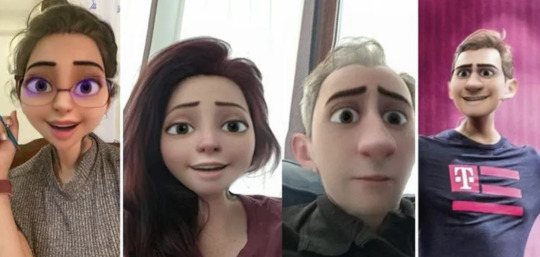
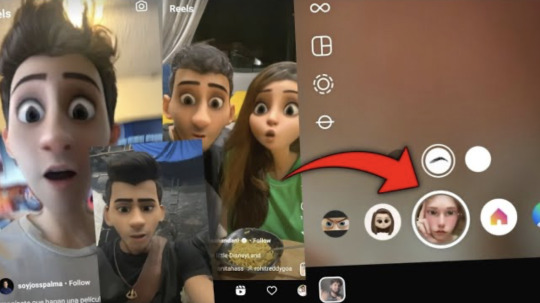
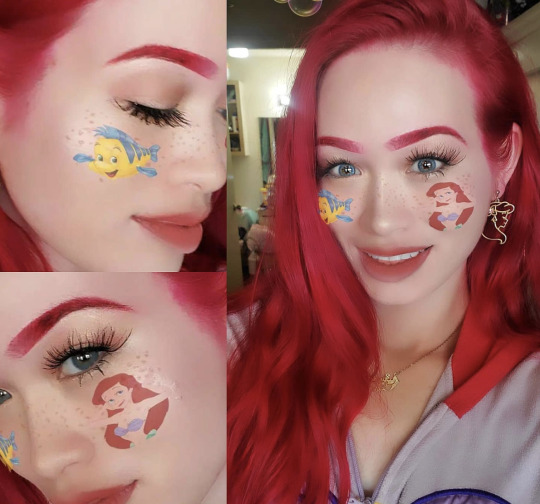
As social media platforms develop alongside a large number of daily users, the virtual space is maximized, allowing everyone access to updated information daily, whether relevant or not. Consequently, users have moved from simply using platforms to complicating matters by magnifying events. With the platforms' aim of constructing online virtual spaces, they intend for them to serve as repositories for memories at every milestone of life. The creation of new features to diversify usage for users enhances the experiential aspect to a new level. Though beneficial, there are unfortunate potential side effects of their use. As previously cited, users tend to post only the most perfect images on social media. Their perception has somewhat shifted from simply posting to preserve memories, to having more demands such as the need for the perfect version of an image, requiring adjustments in composition, color, and contrast, with images often needing filters to make faces more attractive. Some physical features, such as brighter eyes, smaller noses, and rosy cheeks, are notably accentuated by beauty filters on social media platforms. Others entirely transform facial appearances by smoothing out all pores, enlarging lips, and altering eye shapes. Every time users open an app, it feels like they discover a new filter that turns them into an entirely different person.
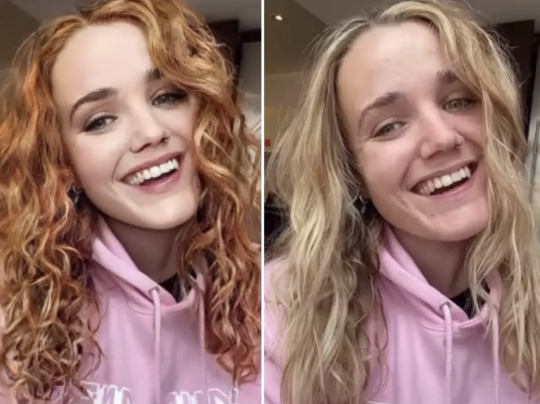
This has caused social media users to become excessively habituated to applying beauty filters to improve their looks and hide imperfections. This is especially true for people who use social media regularly, place high importance on appearances, or are more feminine in personality. The new truth regarding beauty standards in society has been made clear by beauty filters. Women are frequently under pressure from society's standards about certain physical attributes, which makes them think that they are unattractive if they don't have lovely lips, smooth skin, big eyes, a nice jawline, or high cheekbones. Users who use filters to change their looks in an attempt to project a socially acceptable version of themselves risk receiving negative feedback from other users. This highlights a crucial problem by showing how accustomed women have grown to be to filters and how the normalization of unachievable beauty standards for women has taken shape. In addition, users' body image problems are becoming more and more of a worry because of the negative consequences of comparing one's physical appearance to that of others.
Conclusion
The use of filters not only limits itself to enhancing photos but also opens up an entirely new digital world where users can express themselves creatively and uniquely. However, the impact of using filters extends beyond just images and permeates into how we understand digital presence and the information we receive through social media. While using filters on social media contributes to joy and creativity, the misuse and reliance on beauty filters have created a new concept of beauty standards in society and altered citizens' perceptions.
Reference list
Hong, S, Jahng, MR, Lee, N & Wise, KR 2020, ‘Do you filter who you are?: Excessive self-presentation, social cues, and user evaluations of Instagram selfies’, Computers in Human Behavior, vol. 104, p. 106159, viewed <https://www.sciencedirect.com/science/article/pii/S0747563219303711>.
Javornik, A, Marder, B, Barhorst, JB, McLean, G, Rogers, Y, Marshall, P & Warlop, L 2022, ‘“What lies behind the filter?” Uncovering the motivations for using augmented reality (AR) face filters on social media and their effect on well-being’, Computers in Human Behavior, vol. 128, no. 107126, p. 107126, viewed <https://reader.elsevier.com/reader/sd/pii/S0747563221004490?token=C2FCB5A5DF589848E787953D5759B7990EBCED72E6360E2BDA180ED67E63FA10D50C03C6E45357DEA822281F2161C099&originRegion=eu-west-1&originCreation=20220107091932>.
Pettersson, S 2017, ‘Statistics: How Filters Are Used by Instagram’s Most Successful Users’, Kaptur, viewed <https://kaptur.co/statistics-how-filters-are-used-by-instagrams-most-successful-users/>.
Sheldon, P & Bryant, K 2016, ‘Instagram: Motives for Its Use and Relationship to Narcissism and Contextual Age’, Computers in Human Behavior, vol. 58, pp. 89–97, viewed <https://www.sciencedirect.com/science/article/pii/S0747563215303307>.
1 note
·
View note
Text
WEEK 7: Digital Citizenship and Health Education: Body Modification on Visual Social Media
Does Social Media contribute to creating standards of body beauty image?
Social media, a term not unfamiliar to a rapidly developing society, is creating virtual communities instead of traditional communities as in previous years. In this way, communication between people is shortened in terms of geographical distance, and the time to receive and send information during the exchange is significantly reduced without changing the quality of the information. Seeing these benefits, social media is a concept, a collection of “praise-free” platforms that deserves to be created and used the most, right? What social media brings, or specifically, what the smart algorithms of these social media platforms have almost completely changed the behavior, attitudes, and ideologies of users when using them.
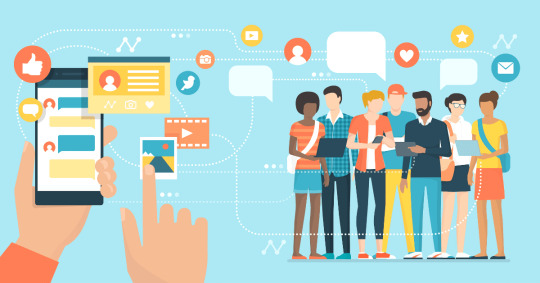
Billions of people worldwide use social media to connect and share information, but the images on social media are filled with people portraying their best versions. The images users post on social media platforms with the desire to preserve memories or simply to be seen by friends who fellow social media users follow, hoping for interaction.
However, frequent exposure to carefully curated posts can influence us and how we perceive beauty, right?
It can be said that an entire generation is growing up based on their beauty standards based on influencers they encounter daily at such a young age. The issue lies in the fact that the individuals who make up a community or even a society, are human beings, citizens, who tend to evaluate and judge as soon as they see someone's photo posted on social media. This happens more often with women as beauty standards are compared between individuals. It affects the content and sharing of photos by women, who constantly seek feedback from social media pages through likes, comments, and follows to elevate their confidence in their perfection and stability (Rosmiati, R, et al. 2023, p. 18). Therefore, it directly affects and arouses dissatisfaction with oneself about body parts, perceived as flaws or weaknesses, doubts about self-esteem, and also encourages self-harming behavior. This stems from the fact that the media always portrays the shapes of women, having "stereotypes" about beauty standards.
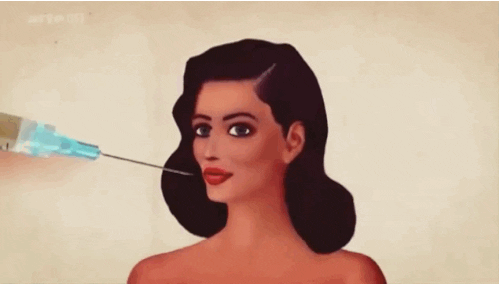

From that factor, body beauty standards are once again surfacing on social media platforms. Compared to 75% of women, over 4/5 of men (80.7%) mention perceived defects and blemishes when expressing concern about their body image (Campbell, D 2017). Users often select and post photos deemed suitable for body beauty standards such as large breasts, enticing hips, high noses, high cheekbones with a seductive smile (for females), muscular bodies, angular faces, thick eyebrows, curly eyelashes (for males). The strong impact on body beauty standards on social media, as everyone wants to be the perfect version of themselves. However, the reality is that no one can touch that perfect beauty, and probably no one admits to having perfect beauty.
Has the boundary between reality and virtuality been sufficiently blurred to necessitate exposure?
“Social media enables users to experience a more personalized connection with celebrities and figures they follow by liking, sharing, and commenting, thus engaging in a more interactive environment rather than just viewing images” (Aziz, J 2017).
Body image standards set on social media platforms will influence users' behaviors, particularly those with influence, fame, or prominence on social media, who tend to alter perceived imperfections of themselves. They are often referred to as microcelebrities, as each appearance on social media, and the images they post are meticulously crafted, relying heavily on layers of makeup, cosmetic surgery, and artificial lighting, with their posts often meticulously edited and specially designed to enhance specific areas.
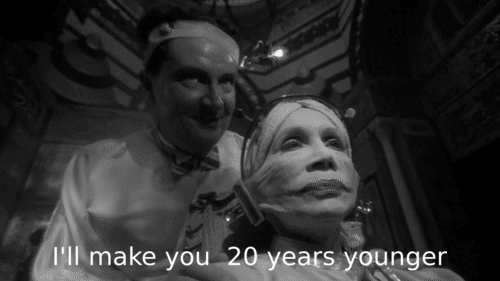
Today’s youth frequently encounter edited facial and body images posted by celebrities and influencers, fostering the notion that they should aspire to unrealistic body types that may ultimately lead to body dissatisfaction. Due to the presence of these influential figures on social media and their posted images, a “fragile ideal” is constructed for these young individuals, deeply ingrained in their body image ideals.
Their posts, accompanied by carefully adjusted images, are considered a conditional response as social media allows users to freely comment, interact, and display widely alongside the content, and images posted by the author. Moreover, regulations regarding digital content pose an entirely different issue, as user-generated content circulates globally, meaning anyone can view what the author posts if they make it public. Those with an “ideal” of body image will reflect it onto their bodies, desiring recognition and esteem from the public sphere, while ordinary individuals, perceiving themselves as flawed in body parts, resort to cosmetic clinics in hopes of reshaping themselves into ideals of perfection. Body dysmorphia is at an all-time high, as ordinary people are constantly encouraged to compare themselves to misleading and distorted images. According to data from the American Academy of Facial Plastic and Reconstructive Surgery from 2017, 42% of surgeons saw patients who wanted to improve their image on Facebook, Instagram, Snapchat, and other social media sites (Dorfman, RG, et al. 2018).
In the ever-evolving digital, those who strive for perfect beauty—a beauty that is defined by society, by social media users, or by so-called digital citizens—obstruct the beauty of what is considered natural, given forth by the most beautiful things. People's self-perception is impacted by the pressure to meet social media beauty standards, which causes them to objectify and commodify their bodies online. Individuals may wish to “enhance”, “control” or “fix” specific areas of their looks or utilize their body as a canvas to express themselves artistically. Certain efforts in body editing may yield unexpectedly negative results, potentially damaging one's self-esteem in the long run.
Beauty Standards and Mental Health
Social media beauty standards are highly detrimental to young girls (Javier 2021), the research shows that over 40% of 9 and 10-year-old girls are attempting to lose weight.
The media has played a significant role in introducing content influencing girls in this manner. This may also account for the rise in hospital admissions for eating problems brought on by social media use. In 2018, data from NHS Digital was made public, revealing that during six years, hospital admissions for eating disorders had doubled, with 13,885 admissions for different eating disorders in the UK (Marsh, S 2018). Furthermore, 28,155 individuals received treatment for eating disorders in the US between 2000 and 2006, an 18% increase in hospitalization times (Zhao, Y & Encinosa, W 2009). This rise corresponds with social media's first appearance in the early 2000s.
These findings have raised concerns about the impact of social media platforms on human mental health, not just virtual personas on social media but also in real life. Medical interventions are attempting to mitigate the negative impact of media-driven beauty standards and promote healthier self-awareness by shifting the emphasis from superficial beauty standards to holistic health and well-being. Attempting to meet unrealistic standards can exacerbate feelings of inadequacy due to the allure of comprehensive health messages promoted by celebrities (Festinger, L 1954).
If I were to say that this mental health impact also affects men, would you believe it?
This is entirely realistic as men also must conform to societal ideals of beauty and perceptions of what constitutes a “man”. There are men out there who naturally lack muscular physiques. This begins to breed insecurity and leads them to develop eating disorders as they struggle to cope with these situations. As a result, the rate of men being treated for eating disorders has increased by 70% from 2010-16 (Beddington, E 2020). This will lead to unpredictable situations as they are at risk of Body Dysmorphic Disorder (BDD), where an individual perceives flaws in their appearance that others may deem insignificant.
Conclusion
Social media has undoubtedly played an undeniable role in shaping body beauty standards, creating a virtual space where users not only connect but also share information, yet also where these standards are created and disseminated. Every photo, every post on social media is a curated, optimized version of oneself, creating a virtual world with elements of perfect beauty. This has led to a lifestyle where measuring beauty based on unrealistic standards has become prevalent, especially among young people.

However, the pressure from these standards affects not only women but also men. Adhering to societal ideals of beauty and perception has caused not only insecurity but also the risk of body and mental disorders. People need to consider carefully how the material they receive on social media affects their body image and sense of self as digital citizens. As such, this problem continues to be a major concern for society and should be thoroughly thought through if the goal is to treat patients using cutting-edge medical procedures or combined with digital technology.
Reference list
Aziz, J 2017, Social Media and Body Issues in Young Adults: an Empirical Study on the Influence of Instagram Use on Body Image and Fatphobia in Catalan University Students, pp. 13–17, viewed <https://repositori.upf.edu/bitstream/handle/10230/33255/Aziz_2017.pdf?sequence=1>.
Beddington, E 2020, ‘I Worry for My Teenage Boys – the Beauty Standards for Young Men Are out of Control’, The Guardian, 28 January, viewed 24 March 2024, <https://www.theguardian.com/commentisfree/2020/jan/28/i-worry-for-my-teenage-boys-the-beauty-standards-for-young-men-are-out-of-control?msclkid=4874d893b81a11ec9e5b9472dc3075f9>.
Campbell, D 2017, ‘Body Image Concerns More Men than women, Research Finds’, the Guardian, The Guardian, viewed <https://www.theguardian.com/lifeandstyle/2012/jan/06/body-image-concerns-men-more-than-women>.
Dorfman, RG, Vaca, EEV, Mahmood, E, Fine, NA & Schierle, CF 2018, ‘Plastic Surgery-Related Hashtag Utilization on Instagram: Implications for Education and Marketing’, Aesthetic Surgery Journal, vol. 38, no. 3, pp. 332–338, viewed 24 March 2024, <https://www.academia.edu/60086545/Plastic_Surgery_Related_Hashtag_Utilization_on_Instagram_Implications_for_Education_and_Marketing>.
Duffy, BE & Meisner, C 2022, ‘Platform governance at the margins: Social media creators’ experiences with algorithmic (in)visibility’, Media, Culture & Society, vol. 45, no. 2, pp. 285–304, viewed <https://journals.sagepub.com/doi/10.1177/01634437221111923>.
Festinger, L 1954, ‘A Theory of Social Comparison Processes’, Human Relations, vol. 7, no. 2, pp. 117–140, viewed <https://journals.sagepub.com/doi/10.1177/001872675400700202>.
Javier 2021, ‘The Effects Of Social Media On Body Image And Mental Health’, Life Sciences Journal, viewed <https://lifesciencesjournal.org/2020/02/the-effects-of-social-media-on-body-image-and-mental-health/>.
Marsh, S 2018, ‘Eating disorders: NHS Reports Surge in Hospital Admissions’, the Guardian, The Guardian, viewed <https://www.theguardian.com/society/2018/feb/12/eating-disorders-nhs-reports-surge-in-hospital-admissions>.
Rosmiati, R, Supriadi, D & Jannah, RR 2023, ‘Relationship of Social Media to Beauty Insecurity in Generation Z Women’, Asy-Syifa : Journal of Science and Technology Nursing, vol. 1, no. 1, pp. 17–27, viewed <https://ojs.stikesmucis.ac.id/index.php/asyjstn/article/view/192>.
Zhao, Y & Encinosa, W 2009, Hospitalizations for Eating Disorders from 1999 to 2006, Agency for Healthcare Research and Quality, viewed <https://hcup-us.ahrq.gov/reports/statbriefs/sb70.pdf>.
0 notes
Text
WEEK 6: FASHION, from the impact of masterpieces to the impact on the environment. The formation of Slow Fashion approaches the ideology of Digital Citizenship
Fashion - a masterpiece, sometimes also hurts the environment
Fashion is considered an offshoot, continuing the artistry, applied to daily life. Not only does it convey the intentions, purposes, and desires of fashion designers in each product they create, but it also holds its meanings and values. Nowadays, in an increasingly developed social era, fashion integration extends to all countries, with fashion also seen as a cultural aspect, bringing interesting differences to each outfit.

Art is a captivating factor that appeals to people through visual perception and then penetrates their emotions. Fashion is no different—clothing worn by individuals carries personal meanings, reflecting their preferences and emotions. According to a 2021 consumer survey conducted in the United Kingdom, over one-third of participants said they go shopping for clothing at least once a month (Chiu, A 2022). A UK-based fashion retail newspaper, Drapers, reported that over one-fifth of respondents stated they make a new buy every two weeks (Fellows, E 2021). Consumer demand is rising, and consumers are using more fashionable yet reasonably priced goods. To satisfy consumer demand, retailers such as Zara, Forever 21, and H&M provide stylish clothes at reasonable prices. Consumers are further encouraged to buy these fast-fashion items by content producers on social media sites, where users are excited to see a variety of fashion posts customized to suit their own styles. Only fast-fashion retailers can develop fresh fashion trends swiftly, which aids in drawing and interacting with viewers on the channels of content providers.
This contributes to the direct impact of global warming and the greenhouse effect that the globe is currently experiencing. According to the United Nations Environment Programme (UNEP), the fashion industry is accountable for around 10% of global carbon emissions (Nijman, S 2019) and is the world's second-largest water user, surpassing the combined emissions of all international flights and maritime transportation. Since 85% of all textiles wind up in landfills every year, they pollute rivers, streams, and water supplies. According to Fall-Johnsen (2019), the act of washing garments alone contributes 500,000 tons of microfibers to ocean pollution per year, which is the same as 50 billion plastic bottles. The United Nations Framework Convention on Climate Change (2018) projects that by 2030, emissions from the textile sector alone will soar by 60%.

Faced with the myriad environmental and humanitarian impacts of fast fashion, slow fashion is gradually gaining attention and making its way into consumers' lives. Not just a trend, slow fashion aims for sustainability to create positive and long-lasting impacts on life and the entire fashion industry. It involves producing and purchasing items with long-term utility and environmental friendliness.
The rise of Slow Fashion, from a phrase to a movement
“The need to effectively apply sustainability and change core values in the fashion industry” is what slow fashion is defined as (Domingos, M, et al. 2022, p. 1). A philosophy “based on slower production, an ethical perspective, and well-made and long-lasting products” is how it is described. (Domingos, M, et al. 2022, p. 2).
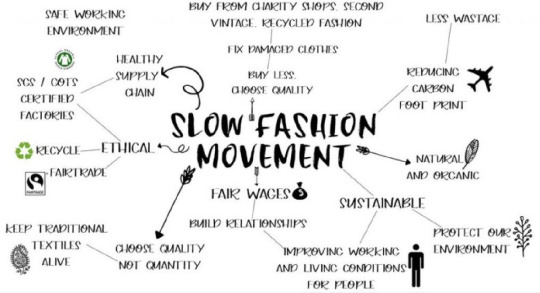
Slow fashion is a fashion trend that contrasts with fast fashion. It encompasses awareness and approaches to fashion, including processes and sourcing of materials for clothing production. This fashion trend is supported by the purchase of higher-quality clothing products that can be used for longer periods. Moreover, it also aims for values beneficial to humans, animals, and our planet. In simpler terms, slow fashion aims to produce and purchase durable, environmentally friendly fashion products. In fact, slow fashion, sustainable fashion, and ethical fashion share similarities. Or, as Claudia Manley, author of "Fashion Writing: A Primer" (2022), puts it, sustainable fashion is part of slow fashion. However, the main difference in slow fashion lies in specific reductions in consumption and production. Slow fashion includes sustainable fashion within it.
Clearly, if the trend of using fast fashion products persists, following the core purpose set by fast fashion companies to survive in the mass fashion market by producing the most fashionable and trendiest clothing in the shortest time possible, so consumers can keep up with fast-changing trends and desire to consume more products (Mehrjoo, M & Pasek, ZJ 2015). According to the usual priorities of fast fashion corporations, these companies repeatedly prioritize profit over ethical principles. Statista's research shows that the global apparel market is worth around $1.53 trillion (Smith, P 2023)—and they have deliberately made it so. The consequences of citizens contributing to the unsustainable nature of the environment become even clearer through data in reports or, more realistically, through personal observation and sensory perception.
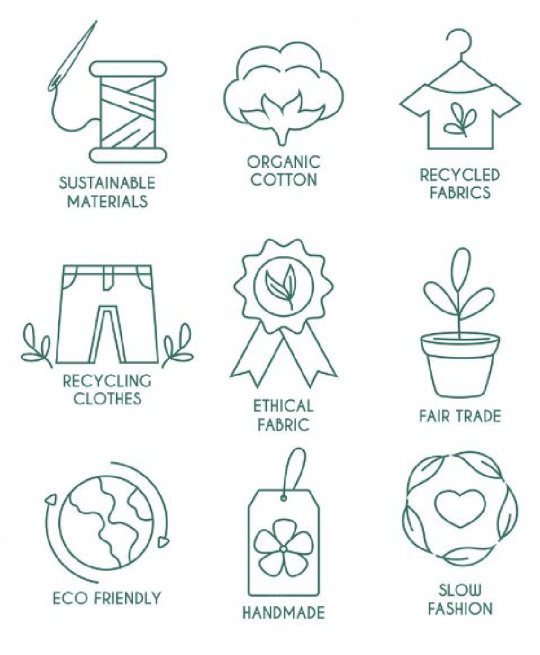
It can be seen that slow fashion emerged to counteract what fast fashion has done and tries to clean up the mess fast fashion has caused for the environment to rebalance the natural ecosystem. Specifically, slow fashion relates to the production and consumption of lagging goods. Therefore, slow production leads to sustainable production because it does not exploit human beings and resources like fast production necessary for fast fashion. With a clear purpose and understanding of the concept of "slow fashion," consumers or citizens have an increasingly heightened awareness of issues related to environmental and social sustainability. This has led to consumer desires surpassing fast fashion systems. As consumers become more informed about social and environmental issues, they put pressure on companies to integrate socially and environmentally responsible activities into their production processes. Clearly, when born, the message of slow fashion is not 'do not buy,' but rather that consumers should slow down their pace and quantity of consumption and purchase high-quality, sustainably produced, and designed products for longevity (Cavender, RC & Lee, MY 2018). The concept behind slow fashion, which opposes consumerism based on trends, fashion cycles, and capitalist machinery, is what distinguishes it as a movement.
Weaving onto the Runways, and daily updating on Social Media, Slow Fashion has changed the ideology of Digital Citizenship
Social media in particular has a twofold impact on how people consume fashion. On the one hand, it normalizes fashion obsolescence and promotes excessive consumption. However, it may also be a potent instrument for encouraging sustainable consumption alternatives and disseminating knowledge about the industry's unsustainable practices. Social media information and expertise have the power to alter customers' perceptions about sustainability and fashion. Unlike traditional fashion magazines or sustainable magazines, social media platforms provide a viable way to encourage youth to participate in more environmentally friendly fashion consumption practices. They frequently spark diverse conversations on several social media networks.
Keywords related to sustainable fashion discourse on Facebook such as "environmentally friendly" and "ethical," often linked to new fashion production methods and "recycling," draw attention to post-consumer textile waste (Youn, C & Jung, HJ 2021). On the other hand, conversations on Twitter mostly center around the fashion industry's production side, albeit they also touch on some consumer-related topics (Orminski, J, et al. 2020). According to a comparison of posts on Twitter and Instagram with the hashtag #WhoMadeMyClothes, the primary themes in these posts are improving working conditions, supply chain transparency, and environmental protection (Modi, D & Zhao, L, 2021), while posts on Twitter contain more knowledge-based messages, Instagram posts lean more towards emotions.

For fashion shows, the showcase of fashion products has witnessed significant changes as designers increasingly integrate sustainability into their collections. Fashion shows have become platforms not only to display exquisite craftsmanship but also to convey powerful messages about ethical practices, environmental responsibility, and moving away from single-use culture. Stella McCartney is famous for creating unique and upscale fashion designs, but what sets her apart is not only her style but also her commitment to sustainability. By integrating these values into every aspect of her design and production work, Stella McCartney has created a sustainable fashion empire with significant influence.
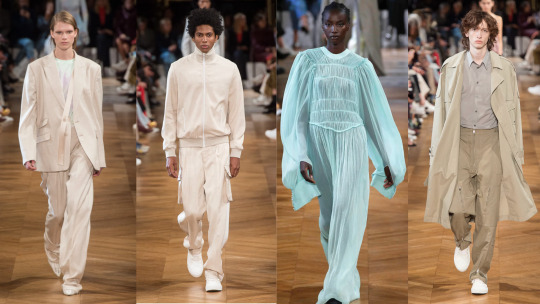
In her Spring/Summer 2019 collection, Stella used organic wool from recycled silk, a material made from recycled silk from creative items such as nylon bags or clothing no longer in use. Instead of using wool from synthetic fibers causing negative environmental impacts, recycling silk helps reduce waste and natural resource depletion.

This not only helps Stella McCartney minimize negative environmental impacts but also sends a strong message about her commitment to sustainability in the fashion industry.
Conclusion
Fashion is regarded as a seductive masterpiece that may express cultural aspirations and subtleties. It pervades worldwide culture and reflects individual choices and feelings. However, fast fashion has created a popular consumption culture that has sustained unsustainable practices, aggravating environmental deterioration.
The rise of slow fashion signifies a significant change in the fashion industry toward sustainability and ethical awareness. Essentially, the development of sustainable fashion is an indication of a larger societal movement toward environmentally conscientious consumerism and care. The growing consciousness among customers regarding the social and environmental consequences of their fashion choices has led to a persistent demand for sustainable substitutes. With its focus on longevity, ethical manufacturing, and quality, slow fashion offers promise for a more sustainable future for the fashion industry.
Reference list
Cavender, RC & Lee, MY 2018, ‘Exploring the Influence of Sustainability Knowledge and Orientation to Slow Consumption on Fashion Leaders’ Drivers of Fast Fashion Avoidance’, American Journal of Theoretical and Applied Business, vol. 4, no. 3, viewed <https://www.researchgate.net/profile/Rayecarol-Cavender/publication/334488005_Exploring_the_Influence_of_Sustainability_Knowledge_and_Orientation_to_Slow_Consumption_on_Fashion_Leaders>.
Chiu, A 2022, ‘You’re Not Going to Stop Shopping for New clothes. Here’s What to Do instead.’, Washington Post, viewed <https://www.washingtonpost.com/climate-solutions/2022/12/06/sustainable-shopping-clothes-climate/>.
Domingos, M, Vale, VT & Faria, S 2022, ‘Slow Fashion Consumer Behavior: a Literature Review’, Sustainability, vol. 14, no. 5, p. 2860, viewed <https://www.mdpi.com/2071-1050/14/5/2860>.
Fellows, E 2021, ‘Sustainability and the Consumer 2021’, Drapers, viewed <https://www.drapersonline.com/guides/sustainability-and-the-consumer-2021>.
Manley, C & Slone, A 2022, Fashion Writing : A Primer, 1st edn, Taylor & Francis Group, ProQuest, viewed <https://www.proquest.com/docview/2735538107/bookReader?accountid=14205&sourcetype=Books>.
McFall-Johnsen, M 2019, ‘How fast fashion hurts the planet through pollution and waste’, Business Insider, viewed <https://www.businessinsider.com/fast-fashion-environmental-impact-pollution-emissions-waste-water-2019-10>.
Mehrjoo, M & Pasek, ZJ 2015, ‘Risk Assessment for the Supply Chain of Fast Fashion Apparel industry: a System Dynamics Framework’, International Journal of Production Research , vol. 54, no. 1, viewed <https://www.researchgate.net/publication/271203817_Risk_assessment_for_the_supply_chain_of_fast_fashion_apparel_industry_a_system_dynamics_framework>.
Modi, D & Zhao, L 2021, ‘Social Media Analysis of Consumer Opinion on Apparel Supply Chain Transparency’, Journal of Fashion Marketing and Management, vol. 25, no. 3, viewed <https://www.emerald.com/insight/content/doi/10.1108/JFMM-09-2019-0220/full/html>.
Nijman, S 2019, ‘UN Alliance for Sustainable Fashion Addresses Damage of “Fast Fashion”’, UNEP - UN Environment Programme, United Nations, viewed <https://www.unep.org/news-and-stories/press-release/un-alliance-sustainable-fashion-addresses-damage-fast-fashion>.
Orminski, J, Tandoc Jr., EC & Detenber, BH 2020, ‘#sustainablefashion – a Conceptual Framework for Sustainable Fashion Discourse on Twitter’, Environmental Communication, vol. 15, no. 1, pp. 115–132, viewed <https://www.tandfonline.com/doi/abs/10.1080/17524032.2020.1802321>.
Smith, P 2023, ‘Global Apparel Market ’, Statista, viewed <https://www.statista.com/topics/5091/apparel-market-worldwide/#topicOverview>.
UNCC 2018, ‘Fashion Industry, UN Pursue Climate Action for Sustainable Development’, United Nations Climate Change, viewed <https://unfccc.int/news/fashion-industry-un-pursue-climate-action-for-sustainable-development>.
Youn, C & Jung, HJ 2021, ‘Semantic Network Analysis to Explore the Concept of Sustainability in the Apparel and Textile Industry’, Sustainability, vol. 13, no. 7, p. 3813, viewed <https://www.mdpi.com/2071-1050/13/7/3813>.
0 notes
Text
WEEK 5: WHAT IS DIGITAL CITIZENSHIP? HASHTAG PUBLICS, POLITICAL ENGAGEMENT AND ACTIVISM
Digital Citizenship Definition
The first ideas of digital citizenship center on people's rights to use the internet and communicate with others, to close the digital gap (Pangrazio, L. & Sefton-Green, J. 2021). Digital Citizenship can also be simply defined as "the right to participate in online society" (Mossberger, K, Tolbert, CJ & McNeal, RS 2007). It emphasizes a dedication to social justice and the freeing and transformational possibilities of technology, with a frequent focus on technological components and digital capacities.

It makes sense that as the Internet continues to grow, so do the chances for people to get involved in social, political, and civic life. The demand for citizens to use social media has proportionally risen, to the extent that nowadays, numerous social media accounts are created every day. Furthermore, since social media sites like Facebook and Twitter have become the primary avenues for involvement, the significance of access rights has decreased. Even pets or infants who do not have the physical ability to move like adults now have their own personal accounts, managed by their owners and parents. Therefore, citizenship rights are practically given in the digital sphere, but they include a variety of duties or activities, such as interpreting news sources or creating a digital identity.
Our engagement with anything larger than ourselves—a community, a platform, or a country—is marked by our digital citizenship (McCosker, A, Vivienne, S & Johns, A 2016). In this view, digital citizenship encompasses new kinds of interaction made possible by the digital sphere as well as civic duty and self-reliance. Digital platforms have a big influence on how individuals participate in politics and how democracy is conducted. The poor voter turnout at Donald Trump's Tulsa campaign rally in June 2020 serves as a prominent illustration of this. This event, which was coordinated via TikTok, united K-pop fans with Black Lives Matter protestors in an unusual partnership. Although it was said to be ‘sold out’, at the rally, the stadium was largely empty (Sakzewski, E 2020)

The importance of Digital Citizenship entails Political Engagement, the power of Hashtags Publics
Since the Internet provides new avenues for political participation, it merits special consideration (Vromen, A. 2016). In addition to non-traditional techniques like blogging, boycotts, texting (e.g., to politicians and the media), and boycotting, online forms of conventional engagement include voting, sending letters to politicians, and making financial donations. These unconventional techniques for personal engagement are frequently quicker, less time-consuming, and useful for expressing political opinions. Because of this, the Internet and online platforms that facilitate rapid and easy connections while also delivering information have come together specially. This has increased the amount of space accessible for the study of politics' personalization, but politics is also being integrated online more and more into other spheres of the economy and society.
With online platforms, it's not hard to notice nouns, adjectives, or a phrase written together behind the "#" sign – this is commonly known as a hashtag, one of the ways that help users quickly access relevant content. Using hashtags can convey strong key points to viewers, making it easy for them not only to access related content quickly but also to preview the content before reading the entire post. Social media mobilization in politics can be viewed as a modernized version of organized media, but given people's intimate connection to media and information, this phenomenon can also be seen as a type of citizen journalism, in which participation is essential to an individual's capacity to obtain and distribute information. Protesters have frequently used Twitter to stay in touch and share information with the globe during demonstrations since it was first developed as a real-time mobile information network.
An example of this is the #MeToo movement, which began in 2006, calling for an end to sexual harassment and assault globally. The movement gained momentum in 2017 when actress Ashley Judd publicly accused powerful Hollywood media mogul Harvey Weinstein of sexual harassment. Gradually, the #MeToo movement spread widely worldwide. On the first day alone, the hashtag was used 200,000 times on Twitter. By the next day, it had been used over half a million times. #MeToo became popular in more than 85 countries with various languages.
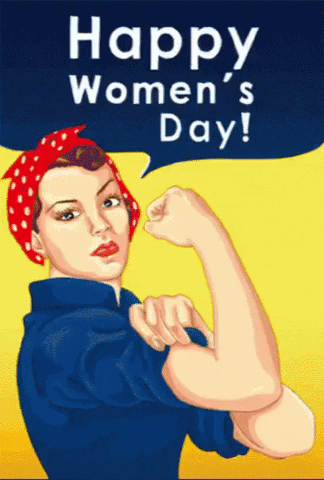
Due to the influence of the movement, women openly spoke up about being victims of sexual harassment or assault, creating an atmosphere of empathy that encouraged other women to share their experiences in similar situations. #MeToo has empowered women to speak out against sexual harassment in various fields and across different countries. The widespread wave has formed a circle of solidarity, letting victims know they are not alone. By raising their voices, they are creating a powerful weapon against this issue. The darkness masked by fame and power, the hidden wrongs covered for years by ultimate authority, are finally brought into the light.
Conclusion
Until recently, theories of personalized collective action—particularly the component of social and political participation—have benefited greatly from the growth of the Internet and emerging trends. This idea not only revolutionizes how people communicate and look for information online, but it also creates a number of new avenues for addressing the enduring political injustices that society faces. One thing to notice is that the Internet serves as a conduit between movements and the general public in addition to being a tool for information dissemination. Participants may readily access and exchange their knowledge, viewpoints, and ideas without difficulty due to the growth and accessibility of the Internet, which eliminates barriers based on geography or language. More than that, it is a way to empower a wider network of shaky ties by including people who might not have had much interaction with any official group.
However, in order to get this degree of varied engagement, it is imperative to confront the issue of whether commonplace kinds of participation can truly mitigate political disparities in citizen participation. Thorough investigation and assessment are required to determine the efficacy of these engagement strategies and their potential to address societal issues such as gender inequality.
Reference list
McCosker, A, Vivienne, S & Johns, A 2016, ‘Negotiating Digital Citizenship: Control, Contest and Culture’, Google Books, Rowman & Littlefield, viewed 23 February 2024, <https://books.google.com.vn/books?hl=en&lr=&id=EePaDwAAQBAJ&oi=fnd&pg=PR7&dq=Negotiating+Digital+Citizenship&ots=oMlh30AtAx&sig=kgDbBUB5Uu01De1g-zhKhLX3BmI&redir_esc=y#v=onepage&q=Negotiating%20Digital%20Citizenship&f=false>.
Mossberger, K, Tolbert, CJ & McNeal, RS 2007, ‘Digital Citizenship: the Internet, Society, and Participation’, direct.mit.edu, MIT Press Direct, viewed <https://direct.mit.edu/books/book/3275/Digital-CitizenshipThe-Internet-Society-and>.
Pangrazio, L & Sefton-Green, J 2021, ‘Digital Rights, Digital Citizenship and Digital Literacy: What’s the Difference?’, Journal of New Approaches in Educational Research, vol. 10, no. 1, pp. 15–27, viewed <https://naerjournal.ua.es/article/view/v10n1-1>.
Sakzewski, E 2020, ‘Did TikTok Users and K-pop Fans Troll Trump’s Tulsa rally?’, ABC News Australia, viewed <https://www.abc.net.au/news/2020-06-22/did-tiktok-users-kpop-fans-really-troll-donald-trump-tulsa-rally/12378768>.Vromen, A 2016, ‘Digital Citizenship and Political Engagement’, Digital Citizenship and Political Engagement, pp. 9–49, viewed <https://link.springer.com/chapter/10.1057%2F978-1-137-48865-7_2>.
0 notes
Text
WEEK 4: REALITY TV CASE STUDY
Reality TV Definition
Reality television has completely transformed the landscape of celebrity, politics, and power dynamics (Berman, J 2022). The prevalence and dominance of reality-based television programs continue to attract significant attention from academia. The term "reality television" often encompasses programs featuring real people or non-actors in unscripted situations (Hill, A 2005; Nabi, RL, Biely, EN, Morgan, SJ & Stitt, CR 2003), prioritizing realism to engage the audience. Editors meticulously curate and select vivid scenes, and authentic moments, as if they were unfolding live. This creates a sense of intimacy for viewers as reality television programs air on TV screens, allowing both the audience and participants to simulate real-time, providing a highly interactive experience that may influence viewers' intentions and attitudes (You, Z, Wang, M & Yangjin Shamu 2023).

Additionally, distinctive details that captivate viewers' attention contribute to the program's fame and extensive coverage. This is the result of editors or program producers incorporating unique, humorous, or contentious scenes, even resorting to offensive remarks directed at individuals. Consequently, at the very moment viewers witness these developments, a multitude of opinions and critiques are formed. The more popular the program, the greater the amplification of discussions surrounding these plot points. It's not solely the program's popularity that determines whether these incidents are condemned or perceived as harmless jokes; the participants in reality television serve as crucial elements in making such judgments. Their roles play a significant role in determining whether a particular plot point is deemed worthy of condemnation or merely an entertaining jest, enriching the viewer's entertainment experience.
However, to achieve popularity and reach the majority of the audience, especially the target demographic, pushing content with discussion-worthy elements, and program comments, is openly shared on public social media. Social media has propelled reality television into a new era. Before people could tweet about their favorite contestants, they simply tuned in each night to see how their television stars were progressing. Utilizing social media as a tool to enhance program coverage is a savvy move, but it also carries inherent risks if not steering the content accurately as planned. Nevertheless, the benefits can be considered to outweigh the drawbacks, as reality television and social media have allowed television audiences to connect with celebrities in a very intimate and private way (Chung, S & Cho, H 2014). They have narrowed the gap between the audience and celebrities, transforming the audience's role from passive viewers and admirers into active participants in the media experience and social circles of these celebrities.
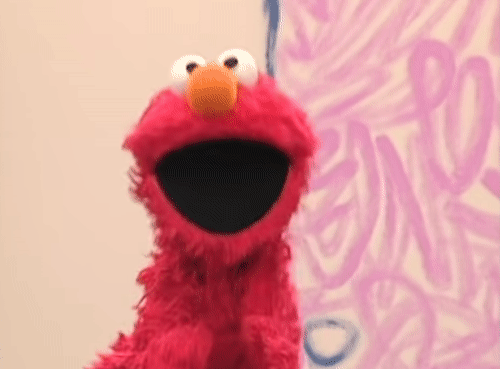
Especially after the episodes of a reality television program air, a substantial number of viewers naturally tune in to watch and evaluate. Subsequently, these individuals invisibly come together to support an individual, a group, or even the entire program, forming what can be described as a fan community. These are the unseen advocates collectively endorsing the program and contributing to its resonance. They may be a group of people who, after watching the program for the first time, found it intriguing and immediately categorized it as a favorite. Alternatively, they could be fan groups of individuals featured in the reality show. Regardless of who they are, they have created a fan community with the common purpose of anticipating the unfolding events of the reality show and discussing specific plot twists.
These fan communities play a pivotal role in amplifying the program's impact and fostering a sense of belonging among viewers. Through online forums, social media groups, or dedicated fan pages, they exchange opinions, and predictions, and even organize events or campaigns to support their favorites. This dynamic interaction not only further engages the audience but also extends the influence of reality television beyond the screen, creating a participatory culture that transcends the traditional viewer-program dynamic.
Stepping from Dramas into the Brilliant Aura: America’s Next Top Model
America’s Next Top Model, created by former supermodel Tyra Banks, first aired on UPN in 2003 and later moved to the CW network during its seventh cycle, remaining one of the consistently highly-rated shows (Musin, J 2013, p. 24). Twenty cycles later, the show has developed into a commercial brand that is syndicated worldwide and aired in more than 170 nations. Approximately twelve would-be models, between the ages of 18 and 27, participate in each cycle and are chosen to live under constant observation with little to no privacy. They live in a gorgeous home with a runway and a pool; the walls are covered in pictures of past competitors. Every cycle and episode has a set structure and covers a range of demanding modeling tasks and photoshoots.
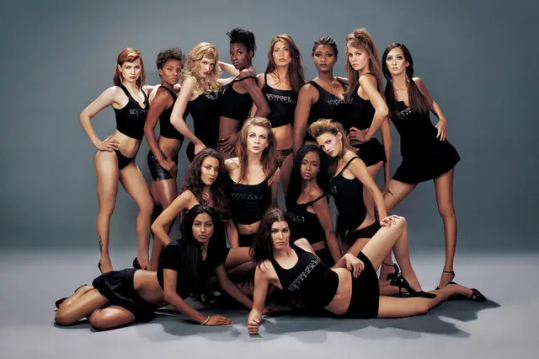
For each girl hailing from different cities and states, they bring with them unique personalities and lifestyles. Successfully passing through the rigorous selection process to live in the shared house is the dream of every contestant in this competition. However, from a different perspective, exposure to such diverse lifestyles is likely to give rise to conflicts in ideologies and thought processes among the girls throughout the challenges on their journey to claim the title of the program.
A recent standout incident involves the clash between two contestants, Liberty Netuschil and Kyla Coleman, the youngest participants in America's Next Top Model Season 24. In the earlier episodes, the images of these two young ladies were somewhat subdued in the eyes of the audience. Liberty was known as a beautiful girl with an orange makeover who had previously secured the top spot for the week, while Kyla had yet to make a significant impression. However, in episode 6, both of these contestants left a distinctive mark. Returning to the shared house after completing a runway challenge at an LGBT bar and receiving Tyra's letter about the upcoming photo shoot related to Drag Queens, the girls were visibly excited. Afterward, a discussion on the topic of Women's Rights erupted between Kyla and Liberty. However, as they did not share the same viewpoint, the issue remained unresolved. Kyla even gestured a middle finger after Liberty finished speaking. Surprisingly, both of these contestants found themselves in the danger zone, and Liberty was the person who was ultimately eliminated.


Another poignant moment in America’s Next Top Model Season 24 was the emotional wig reveal of contestant Jeana Turner. Jeana, who has suffered from an autoimmune disease since childhood, lost all her hair. During the makeover challenge, the judges encouraged her to showcase her natural beauty instead of opting for a new look with a wig. Creative director Drew Elliott was left speechless the moment Jeana embraced her authentic self in front of the camera. Stylist Law Roach was also deeply moved, shedding tears at the 24-year-old contestant's courage. As a result, during the elimination round, both judges, Law Roach and Drew Elliott, decided to cut off Jeana's signature long hair. This event surprised and captivated all the contestants and viewers alike after the episode aired.
While America’s Next Top Model is renowned for being a reality show filled with drama, this particular episode showcased not only the controversies and dramas between the girls but also the human stories and inspiring moments. It highlighted that, beneath the surface of the intense competition, the show continues to tell compelling and uplifting stories.
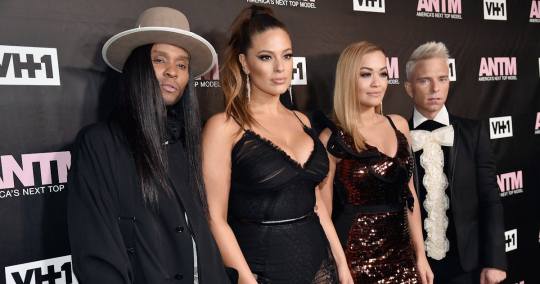
Conclusion
It can be said that the elements mentioned above have made America’s Next Top Model irresistibly captivating, not only within the United States but also spreading its influence globally. Many countries have acquired the rights and started producing program with similar content and format, examples of which include VNTM (Vietnam’s Next Top Model), GNTM (Germany's Next Top Model), and so on. America’s Next Top Model stands out as an example due to its surreal nature, unscripted actions in various scenarios, and unexpected outcomes. This aspect keeps the audience intrigued and eagerly anticipating each episode. Because of these captivating elements, social media platforms are flooded with content snippets from the reality show along with comments, generating immense interest from the audience.
The way that we interpret media art and engage with it has been greatly impacted by reality television. Making reality-based television shows is a great way to get recognition and attention, but it also opens up new social media avenues for communication and engagement. Reality television's ability to forge strong bonds between viewers and participants has resulted in vibrant fan groups that shape public perceptions and assessments. In this sense, reality TV serves as more than simply a source of pleasure; it also can create and influence virtual communities and change the way viewers interact with and perceive artistic works in media.
References list
Berman, J 2022, ‘Reality TV Has Reshaped Our World, Whether We like It or Not’, Time, <https://time.com/collection/reality-tv-most-influential-seasons/6199108/reality-tv-influence-on-world/>.
Chung, S & Cho, H 2014, Parasocial Relationship via Reality TV and Social media: Its Implications for Celebrity Endorsement, <https://www.researchgate.net/publication/266658905_Parasocial_relationship_via_reality_TV_and_social_media_Its_implications_for_celebrity_endorsement>.
Hill, A 2005, ‘Reality TV: Audiences and Popular Factual Television’, Google Books, Psychology Press, viewed 21 February 2024, <https://books.google.com.vn/books?id=CKGSHmmSd70C&pg=PA14&source=gbs_toc_r&cad=2#v=onepage&q&f=false>.
Musin, J 2013, Docile and Disciplined: What It Takes to Become America’s next Top Model, p. 24, <https://www.monash.edu/__data/assets/pdf_file/0004/1668370/musin1.pdf>.
Nabi, RL, Biely, EN, Morgan, SJ & Stitt, CR 2003, ‘Reality-Based Television Programming and the Psychology of Its Appeal’, Media Psychology, vol. 5, no. 4, pp. 303–330.
0 notes
Text
WEEK 3: TUMBLR CASE STUDY
Once dominating the social media platform scene, boasting 108.5 million registered blogs and 50.9 billion posts (The Economist 2013), Tumblr surpassed its competitors to become a platform with over 20 billion page views per month at that time, as stated by its founder, David Karp. The question arises: Can this social media platform withstand the continuous emergence of competing platforms such as Facebook, Instagram, and notably, TikTok?
What is Tumblr?
Tumblr - being one of the distinctive microblogging platforms (Chang, Y et al. 2014), has become a phenomenon, a usage habit among Generation X and Y.

The site itself offers users the opportunity to upload original or reblogged text entries, photos, quotations, links, chats, audio, and videos, as well as original or reblogged pictures and quotes. It is possible for users to "like" or "reblog" posts from other blogs so that they show up on their own blogs. This allows users to freely add their own opinions, analysis, and substance to postings without taking away from the original author's credit. Tumblr facilitates the development of both individualism and communities in this way; information that is repurposed, altered, and uploaded to a personal blog space stays current and connected to a broader community (Tumblr's dashboard and archive).
Because of this, Tumblr is a great platform for people to come together and connect, especially those who belong to underrepresented groups or individuals in society who need to speak up and fight for justice, such as members of the LGBTQ+ community, people of color, and advocates of women's rights. They are free to speak up here without fear of retaliation or intimidation. Additionally, people may identify and obtain information on topics they are interested in fast when hashtags are used to highlight or summarize important points in messages. It also gets easier to connect with people who share your interests, and most significantly, Tumblr gives them a sense of security.
Tumblr - a place where every opinion seems to have no template
The blogging site came into being at a period when the women's rights movement was getting more contentious in a few particular nations. Tumblr is therefore seen as a location where they may look for allies and attract people for the cause inside the community. In this instance, they discuss viewpoints on the feminist movement, important elements, and a new mode of operation as social media usage increased during that period. Online Social Networks (OSN) have profoundly changed the Internet ecosystem and permeated every part of peoples' everyday lives (Zhang et al. 2021). Even if there was a feminist wave at the time, social media was not extensively available in other countries, such as Vietnam, in its early years. This was because women could no longer endure the oppression, exploitation, and coercion of the “gender prejudice, take a male-centered” ideology.

It is essential to have the freedom to voice one's own thoughts, particularly when it comes to societal or personal matters that need deliberation before a choice is made. One of Tumblr's best features is the "reblogging" option, which not only extends the reach of postings but also tactfully conveys support for the author's point of view. This has made it easier for many viewpoints that were once marginalized or even silenced in public to gain support in the online community. By sharing personal perspectives, feminists may readily connect and engage with one another, resulting in a more real and expansive vision. Through internet and other media platforms, the feminist movement has grown significantly with the times. Since then, a number of further "Femvertising" (Feminism & Advertising) efforts have surfaced, according to Samantha Skey, CEO of She Knows. These ads use feminism-supporting messaging and imagery to create awareness of human self-worth, such as equal rights, hence empowering women and girls (Skey, S 2015).
One such example of severe discrimination against women is the ideal of beauty. In today's contemporary world, it is true that every nation and ethnic group has established its own criteria for beauty; nonetheless, a common model, or standard of beauty, for women is defined as having white skin, large eyes, a sharp jawline, pointed noses, full lips, slender bodies, and so forth. A critical society tends to support the establishment of norms for attractiveness and physical appearance (Raaziya, S 2023). Women who have long backs or somewhat chubby bodies are therefore frequently criticized by society, which has a negative psychological effect on them. They may express their opinions online on the problem of establishing norms for women's bodies thanks to Tumblr's open community. Those in positions of authority are free to utilize hashtags to explicitly state or imply what they believe and have said above.
Case study: “Love the Skin You’re In”: An Analysis of Women’s Self-Presentation and User Reactions to Selfies Using the Tumblr Hashtag #bodypositive
Because beauty standards are so strict, viewers and users on the internet have different ideas about what constitutes acceptable beauty. For instance, people expect superstars, exceptional actors, and beauty queens to have exceptional outward looks. Princesses are always shown as being very lovely in fairy tales, regardless of where they come from. These ideas have developed into ideologies over time. The above-mentioned case study aids in understanding the phenomena of selfies, in which users of social media frequently snap and share photos of themselves with attractive bodies, engaging personalities, or appealing viewpoints. Despite Tumblr's significant degree of variety, this is a result of individuals being too critical of themselves and having their psyches strongly affected to conform to conventional beauty standards. Likes and positive comments are considered a measure of a user's beauty and self-worth (Tiidenberg, K et al. 2015).
“Love the Skin You're In” is akin to a declaration that accepting and appreciating your physical attributes—be they large or tiny eyes or powerful biceps—is essential. Using hashtags in the feminist movement will help like-minded people communicate, as they recognize the severe problem of over-idealizing oneself and enforcing standards that are regarded as unnecessary. While the #selfie may be well-liked, but #bodypositive may empower people by facilitating the expression of many kinds of femininity and body shapes. These particular hashtags—like the hashtag #feminism, for instance—support gender equality online by aligning with the fourth wave of feminism.
When new platforms were coming, what’s happened to Tumblr?
Undoubtedly, Tumblr was once a secure place to voice one's personal beliefs. Though this site offered many distinct characteristics at first, the rise of competing social media networks has introduced several drawbacks.
According to Statista (2024), Tumblr faces threats from prominent online platforms like Meta (Facebook and Instagram) and TikTok, since its user base has shrunk from its early days. Popular photo-sharing websites Facebook and Instagram let users share and create highlights from photographs to help preserve special moments. The simplicity with which users can connect these two platforms—sharing moments on Instagram, for example, may instantly publish those memories to Facebook—is what makes this convenient. Instagram is frequently thought of as a place to explore companies, places, and events as well as find new trends. People utilize it to get fresh ideas and as a source of visual inspiration. Facebook, on the other hand, places more emphasis on interpersonal relationships and is largely used by users to engage with information published by friends and family.
With TikTok, a platform that has grown rapidly in recent years, particularly during the risky COVID-19 pandemic era when lockdowns enforced by the government forced most people to stay indoors in order to slow the virus's spread. TikTok's broad appeal may be ascribed to a number of elements that serve users' varied interests. Those looking for quick and interesting material may find the platform's short-form content structure, which lasts between 15 and 60 seconds, appealing. TikTok's intuitive UI, extensive music collection, and simple editing capabilities make it easier to create content.
This is a significant obstacle for Tumblr since the younger generation is constantly looking for original and creative material. TikTok's development also means that Tumblr now has restrictions since content producers can use TikTok to share important information, support or oppose movements, warn users, and voice their own opinions.
Conclusion
To put it briefly, Tumblr continues to be a secure space for ideas and a fair forum for expressing opinions, assisting users in being integrated into the online communities in which they actively participate. Not only is Tumblr a social networking site, but it's also a developing online community where people actively celebrate diversity and self-affirmation. Because it “offers special social privacy to feminist girls, giving a sense of protection from both family, friends and anonymous trolls”, women on this social network have also grown stronger as a group to engage in virtual feminist action (Keller, J 2019, p. 9).
References list
Chang, Y, Tang, L, Inagaki, Y & Liu, Y 2014, ‘What Is Tumblr’, ACM SIGKDD Explorations Newsletter, vol. 16, no. 1, pp. 21–29.
Keller, J 2019, ‘“Oh, She’s a Tumblr Feminist”: Exploring the Platform Vernacular of Girls’ Social Media Feminisms’, Social Media + Society, vol. 5, no. 3, p. 9, <https://journals.sagepub.com/doi/epub/10.1177/2056305119867442>.
Raaziya, S 2023, ‘Dominating Beauty standards: 4 Reasons Why High Beauty Standards Are Dangerous’, The Times of India, <https://timesofindia.indiatimes.com/readersblog/awesome-reads/dominating-beauty-standards-4-reasons-why-high-beauty-standards-are-dangerous-50709/>.
Skey, S 2015, ‘Femvertising’, She Knows, <http://cdn.sheknows.com/corporate.sheknows.com/production/nodes/attachments/24521/iBlog_Magazine-SheKnows-FemvertisingFeature.pdf?1429105587>.
Statista 2024, ‘Most Popular Social Networks Worldwide as of October 2023, Ranked by Number of Monthly Active Users’, Statista, <https://www.statista.com/statistics/272014/global-social-networks-ranked-by-number-of-users/>.
The Economist 2013, ‘What Is Tumblr?: the Economist Explains’, The Economist Online, ProQuest, viewed 20 February 2024, <https://www.proquest.com/docview/1353645764/857325A83B084F08PQ/2?accountid=14205&sourcetype=Magazines>.
Tiidenberg, K & Gómez Cruz, E 2015, ‘Selfies, Image and the Re-making of the Body’, Body & Society, vol. 21, no. 4, pp. 77–102, <https://journals.sagepub.com/doi/epub/10.1177/1357034X15592465>.
Zhang, L, Li, K & Liu, J 2021, ‘An Information Diffusion Model Based on Explosion Shock Wave Theory on Online Social Networks’, Applied Sciences, vol. 11, no. 21, p. 9996, <https://www.mdpi.com/2076-3417/11/21/9996>.
1 note
·
View note